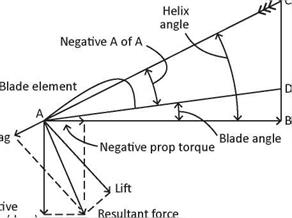Windmilling Prop Forces
In the event of an engine failure, the prop will continue to turn or windmill for some time after the engine has failed if the prop is not feathered. The force required to turn the prop is provided by the energy in the air flowing through the prop disc due to the forward motion of the aircraft. Referring to Diagram 17, Windmilling Prop Forces, the propeller’s rotational velocity (A-B) is assumed to have decreased but the aircraft’s forward speed is still relatively high (assume the aircraft to be in a glide). The vector (A-C) or relative air flow
(RAF) will strike the prop blade at a negative angle of attack assuming the prop path to be unchanged for the moment. In this condition, the helix angle will be greater than the blade angle and the angle of attack will be negative, the reverse of the normal cruise positions. The negative prop torque acts in the direction of propeller rotation powering the prop to a fast idle speed. With the engine failed, there is no engine torque to oppose prop torque. If the forward speed is increased by lowering the nose, the advance per rev vector (B-C) will be extended, increasing the negative angle of attack and in turn, increase the prop RPM
By reducing the aircraft’s forward speed, the windmilling prop drag can be reduced. Less drag is always an advantage on single-engine aircraft because it reduces the angle of descent allowing more time and a greater distance to be covered in the ensuing forced landing. The reduced windmilling drag on
![]()
![]()
 Negal
Negal
thrust (drag)
Diagram 17, Windmilling Prop Forces
a twin-engine aircraft will lower the minimum control speed (VMC) enhancing engine-out handling. Diagram 17, also shows a reduced forward speed will reduce the advance per rev vector (B-C). The helix angle (AB-AC) will also reduce, thereby reducing the prop blade’s negative angle of attack, which in turn reduces the lift coefficient and the resultant force and hence, it reduces the negative thrust (or drag).
The resultant force acting in the rearward direction produces undesirable negative thrust, known as parasite drag, or more commonly as windmilling drag. The negative prop torque component of the resultant force acts in the plane of rotation causing the prop to windmill. The amount of drag produced depends on the pitch of the prop blades. Additional drag is produced when the prop is set to fine/flat pitch due to it greater negative angle of attack. A coarse pitch setting should be selected for a lower blade angle of attack, less drag and a lower critical speed on a twin-engine aircraft. Coarse pitch will also help to stop the prop from rotating. The windmilling prop drag reduces the overall lift/drag ratio of the aircraft from an average 15:1 to 11:1. The result will be a much steeper glide angle, hence the need to select coarse pitch The drag of a turboprop’s windmilling propeller can be excessively high and dangerous, with the fixed-shaft turbine engine being the worst case due to its inherent design. The drag of a free – turbine engine is only 25% of the fixed-shaft engine.











